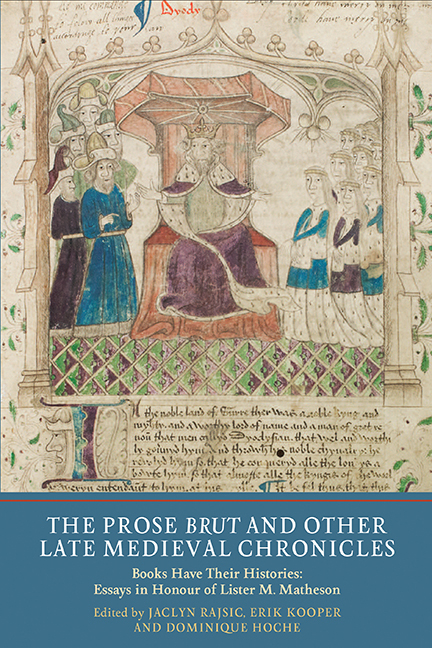 The Prose Brut and Other Late Medieval Chronicles
The Prose Brut and Other Late Medieval Chronicles Book contents
- Frontmatter
- Dedication
- Contents
- List of Plates
- List of Contributors
- Acknowledgements
- Curriculum Vitae of Lister M. Matheson
- Introduction
- A Memoir: The Whole Haggis: Lessons From the Work of Lister M. Matheson
- Part I Uses of History
- Part II The Prose Brut
- 5 Longleat House MS 55: An Unacknowledged Brut Manuscript?
- 6 Peculiar Versions of the Middle English Prose Brut and Textual Archaeology
- 7 The English Prose Brut Chronicle on a Roll: Cambridge, Corpus Christi College, MS 546 and its History
- 8 Re-Printing or Remaking? The Early Printed Editions of the Chronicles of England
- Part III Receptions and Afterlives of Late Medieval Chronicles
- Index of Manuscripts Cited
- General Index
- Tabula in Memoriam
6 - Peculiar Versions of the Middle English Prose Brut and Textual Archaeology
from Part II - The Prose Brut
Published online by Cambridge University Press: 05 July 2016
- Frontmatter
- Dedication
- Contents
- List of Plates
- List of Contributors
- Acknowledgements
- Curriculum Vitae of Lister M. Matheson
- Introduction
- A Memoir: The Whole Haggis: Lessons From the Work of Lister M. Matheson
- Part I Uses of History
- Part II The Prose Brut
- 5 Longleat House MS 55: An Unacknowledged Brut Manuscript?
- 6 Peculiar Versions of the Middle English Prose Brut and Textual Archaeology
- 7 The English Prose Brut Chronicle on a Roll: Cambridge, Corpus Christi College, MS 546 and its History
- 8 Re-Printing or Remaking? The Early Printed Editions of the Chronicles of England
- Part III Receptions and Afterlives of Late Medieval Chronicles
- Index of Manuscripts Cited
- General Index
- Tabula in Memoriam
Summary
IT is now over 100 years since the publication of Friedrich Brie's edition of the Middle English Prose Brut for the Early English Text Society, and a much shorter time since the publication of Lister Matheson's The Prose Brut: The Development of a Middle English Chronicle (1998). Both works are watersheds in the history of scholarship on the medieval Prose Brut and vernacular historical narrative in general. Lister Matheson's book is a more accurate representation of the nature of the Brut, which, like many large medieval texts, is a truly fluid work that has the capacity to reflect and respond to changes in taste, changes in the languages, and, most of all, because of the nature of the subject matter, changes in the political and cultural climate of medieval Britain. It is the word development in Lister Matheson's subtitle that signals the direction for his study, which highlights the nature of the body of texts that is referred to as the medieval Prose Brut, be it Anglo-French, Middle English or Latin, by demonstrating that it was a text that was in a constant state of change and was constantly being reinvented.
Understood in this way, the question that the Brut provokes is what are the dynamics of its development? Or, what drives the development of the Brut to produce such a disparate and, one might say, undisciplined body of texts? There are many ways in which it is possible to investigate this question, but this essay focuses on examples from what Lister Matheson referred to as the ‘peculiar texts’ of the Middle English Prose Brut. The term ‘peculiar’ is one he inherited from the early work on the Brut by C. L. Kingsford in his monograph English Historical Literature of the Fifteenth Century (1913), and Kingsford used the term in its older sense of ‘particular’, ‘distinctive’ or ‘special’. Among the Brut texts, the ‘peculiar versions’ are those that most invite investigation and speculation; they are, it can be argued, the most obvious products of cultural or political change, or, in some cases, cultural or political anxiety. However, we only become aware of their distinctiveness when we understand how they are constituted.
- Type
- Chapter
- Information
- The Prose Brut and Other Late Medieval ChroniclesBooks have their Histories. Essays in Honour of Lister M. Matheson, pp. 94 - 104Publisher: Boydell & BrewerPrint publication year: 2016
